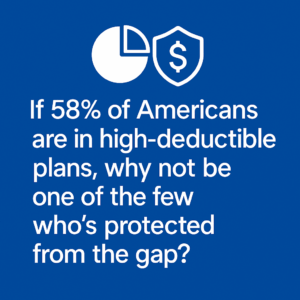Gap Plan in 2026
Health insurance in the U.S. is changing fast — and not always in ways that help families. With premiums climbing, deductibles creeping higher, and uncertainty about whether ACA subsidies will continue, many Americans are being nudged into lower-cost, higher-risk plans.
That means more financial responsibility lands directly on you. And that’s where a gap plan comes in — as an affordable, practical way to shield your family or employees from devastating out-of-pocket costs.
The Push Toward Bronze and Catastrophic Plans
Marketplace trends show insurers steering people toward bronze and catastrophic coverage. On paper, these plans look attractive: lower monthly premiums. But the catch is painful:
- Bronze plan deductibles often run $7,000+ per person before insurance pays much of anything.
- Catastrophic plans can saddle you with out-of-pocket costs tied to the maximum allowed by law, sometimes $9,000–$10,000 per year.
- Even “expanded bronze” designs allow insurers to reduce coverage value while keeping the same label.
In other words, you save a little on premiums, but the first $7,000–$10,000 of medical care is on you.
Subsidy Uncertainty Makes Planning Riskier
The enhanced ACA subsidies that lowered premiums for many families are set to expire unless extended. Without them:
- Families who qualified for premium help may see net premiums skyrocket overnight.
- Plan designs in 2026 will allow lower actuarial values, meaning a “silver plan” might cover less than you think.
- Even if you qualify for subsidies, your deductible and coinsurance still apply — subsidies don’t shield you from the high costs of actually using your plan.
This creates massive uncertainty for household budgets.
Why Gap Plans Are the Smart Play
A gap plan isn’t meant to replace health insurance. It’s meant to protect you from the worst financial shocks when you need care most.
| Problem | Without Gap Plan | With Gap Plan |
| Hospital stay on a $7,500 deductible plan | You pay most or all of that $7,500 before coverage | Gap plan helps cover the deductible, protecting savings |
| Outpatient surgery with 20% coinsurance | $2,000+ bill even after insurance pays its share | Gap plan cushions the blow with cash benefits |
| Rising premiums force you into a cheaper bronze plan | Bigger deductible + higher out-of-pocket exposure | Gap plan fills in the holes and gives you predictability |
Real-World Reminder: GoFundMe Isn’t Insurance
We’ve all seen it — heartbreaking GoFundMe campaigns asking friends and strangers to help cover medical bills. Families shouldn’t have to beg for help just to get care.
A gap plan in 2026 is about dignity, preparedness, and peace of mind. It’s the financial parachute you hope you never need, but will be grateful for if life throws a curveball.
FAQs About Gap Plans
- Do gap plans replace my health insurance?
No, they work with your plan to cover deductibles, copays, and coinsurance. - How much do gap plans cost?
Typically much less than raising your coverage level (e.g., bronze to gold). - Do I get to choose how benefits are used?
Yes — benefits can be applied toward your medical bills or out-of-pocket costs. - Will a gap plan help if subsidies go away?
Absolutely. Subsidies lower premiums, but not deductibles or coinsurance. - Do employers benefit too?
Yes — gap plans offered as a cafeteria benefit are tax-deductible for businesses.
The Bottom Line
Health care costs in 2026 and beyond are moving in one direction: up. With more families being funneled into bronze and catastrophic coverage, the risk of financial harm grows every year.
A gap plan in 2026 is a practical, affordable way to balance the scales — protecting your budget, your savings, and your family’s peace of mind.
Here at TCG Insurance Solutions, we realize the importance of maximizing your hard earned dollars and seek ways to protect you from out of pocket costs associated with health insurance.



